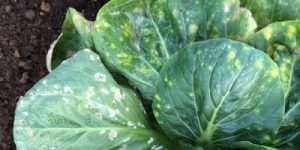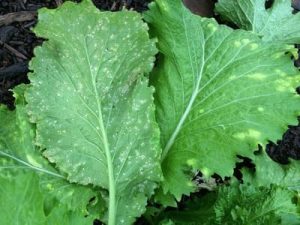White rust, a fungal disease caused by Albugo species, is a silent yet destructive threat to your garden. It manifests as white pustules or blisters on plant surfaces and, if left untreated, can weaken plants, disrupt photosynthesis, and even lead to significant crop losses. Fortunately, with prompt action and proper care, you can tackle this issue effectively. This guide will cover everything you need to know about identifying, preventing, and removing white rust to ensure your plants thrive.
What is White Rust?

White rust is a plant disease that predominantly affects cruciferous vegetables like spinach, cabbage, mustard greens, and radishes, as well as ornamental plants. Unlike traditional rust fungi that produce reddish-brown spores, white rust creates white or light-yellow pustules on the underside of leaves and stems.
These pustules eventually burst, releasing fungal spores that spread through wind, water splashes, or contaminated tools. The disease thrives in cool, wet conditions, making spring and fall peak seasons for outbreaks. Early detection is crucial to stopping the spread before it damages your entire garden.
Symptoms of White Rust

To address white rust, it’s essential to recognize its symptoms early. Look out for:
- White or pale-yellow blisters on the underside of leaves.
- Leaf distortion as the infection progresses.
- Premature yellowing and dropping of infected leaves.
- Stunted growth in severely affected plants.
Regularly inspect your plants, especially during cool and damp weather, to spot these signs before the disease spreads.
Prevention: Your First Line of Defense Against White Rust

Preventing white rust is far easier than treating an established infestation, and a proactive approach will keep your garden healthy and fungal-free. By following these best practices, you can reduce the risk of rust and other fungal diseases from taking hold in your garden:
Proper Plant Spacing
One of the most effective ways to prevent white rust is by ensuring proper plant spacing. When plants are too crowded, they create humid microenvironments that encourage the growth of fungal spores. Proper spacing improves air circulation around your plants, allowing them to dry out faster after watering or rain. This helps reduce moisture buildup, which is crucial for preventing the spread of rust fungus. Additionally, good airflow promotes overall plant health and reduces the risk of other diseases.
Water Wisely
Watering plays a significant role in controlling the spread of white rust. Overhead watering can wet the foliage, which creates the perfect conditions for fungal spores to germinate and spread. Instead, opt for a drip irrigation system, which delivers water directly to the soil, keeping the leaves dry and reducing the chance of infection. If overhead watering is necessary, try to water early in the day so the plants can dry before evening. Avoid wetting the foliage during the evening hours, as the longer dampness lingers, the greater the risk of fungal growth.
Rotate Crops
Crop rotation is another crucial step in managing white rust and preventing future outbreaks. White rust spores can survive in the soil, waiting to infect successive plantings. By rotating your crops and alternating rust-resistant plants with susceptible ones, you can break the disease cycle and limit the fungus’s ability to thrive. This practice helps reduce the overall pressure of disease in your garden, making it harder for rust fungus to establish itself year after year.
Maintain Cleanliness in the Garden
Keeping your garden free of plant debris and weeds is vital in the fight against white rust. Fallen leaves and weeds can harbor fungal spores, which can spread throughout your garden, infecting healthy plants. Regularly clear away plant debris and dispose of it properly—don’t compost it, as this can encourage the spread of spores. Additionally, disinfect your gardening tools and equipment after use to prevent cross-contamination between infected and healthy plants. Clean tools help stop the unintentional spread of fungal diseases like white rust.
By following these prevention techniques—ensuring proper spacing, watering wisely, rotating crops, and maintaining cleanliness—you can significantly reduce the risk of white rust taking hold in your garden. Implementing these proactive measures will keep your plants healthy and protect them from the damaging effects of fungal infections.
How to Remove White Rust from Plants

If white rust has already appeared in your garden, follow these steps to remove it effectively and prevent further damage:
- Remove Infected Plant Parts: To effectively manage white rust and prevent further spread, it’s crucial to prune infected plant parts as soon as you notice symptoms. Carefully trim away the affected leaves and stems, making sure to dispose of them properly. Avoid composting diseased material, as fungal spores can survive in compost and reinfect your garden. Instead, bag and discard the infected plant parts in the trash to stop the spread of rust fungus and protect healthy plants from future damage.
- Apply Organic Fungicides: When dealing with white rust in your garden, using organic treatments like neem oil and sulfur sprays can be both safe and effective for managing fungal diseases. These natural options work by targeting the fungal spores and disrupting the life cycle of the rust fungus.Neem oil is particularly beneficial because it acts as a broad-spectrum fungicide. It interferes with the fungus’s ability to reproduce, preventing spore germination and inhibiting further spread. Neem oil is also safe for beneficial insects like bees and ladybugs, making it an eco-friendly solution for your garden. When applied regularly, it can significantly reduce the rust fungus population, helping your plants recover and thrive.
On the other hand, sulfur-based fungicides create a protective barrier on plant surfaces, safeguarding them from future fungal attacks. These fungicides are effective at killing the spores that cause white rust while being gentle on the plants themselves. Sulfur also works by altering the pH on the plant’s surface, making it an unfavorable environment for the rust spores to develop. Both neem oil and sulfur are great options for those seeking natural treatments for white rust without relying on harsh chemicals. By incorporating these into your garden care routine, you’ll help maintain a healthy, thriving garden free of damaging fungal diseases.
- Introduce Baking Soda Solutions: A natural remedy, baking soda sprays alter the pH of plant surfaces, making them inhospitable to fungal growth. Mix one tablespoon of baking soda with a gallon of water and a few drops of liquid soap for a DIY fungicide.
- Use Chemical Fungicides for Severe Infections: For advanced stages of white rust, chemical fungicides containing Myclobutanil, Chlorothalonil, or Mancozeb can be used. These products are highly effective but should be applied carefully according to the manufacturer’s instructions.
Long-Term Management Tips
Once white rust has been eradicated, adopt these strategies to keep your garden rust-free in the long term:
- Choose Resistant Varieties: Many plants are bred for resistance to fungal diseases. Opt for these varieties when planning your garden.
- Monitor Regularly: Early detection is key. Inspect your plants frequently, especially during cool, damp conditions.
- Improve Soil Health: Healthy soil rich in organic matter and nutrients boosts plant immunity, making them less susceptible to infections.
Why Addressing White Rust Matters
Unchecked white rust not only damages individual plants but can also spread rapidly across your garden, affecting yields and aesthetics. Removing white rust promptly:
- Restores plant health and vigor.
- Prevents further spread to nearby crops.
- Saves time and money on extensive treatments later.

By following effective prevention, removal, and long-term management strategies, you can successfully protect your plants from the damaging effects of white rust. Whether you’re managing a vegetable garden or growing ornamental plants, taking a proactive approach to combating rust fungus will ensure your garden remains healthy and productive. Implementing these white rust control methods, such as using organic fungicides and choosing rust-resistant plants, helps maintain a flourishing garden free from fungal diseases. Regular monitoring and good garden hygiene are essential for preventing future white rust outbreaks.
For more gardening tips and detailed fungal disease guides, explore related articles to enhance your expertise!
8 Common Pests and Easy Ways to Repel Them
How to Attract Earthworms to Vegetable Garden

